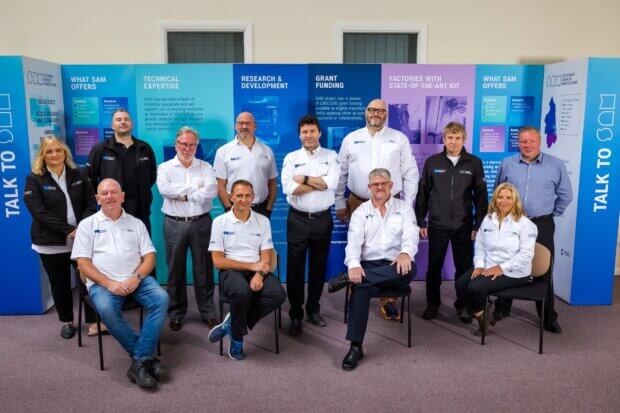I’ve worked across different areas of design for 25 years, spanning graphics, web, user interface and experiential design through, more recently to XR:- Extended reality which essentially encompasses VR – Virtual Reality and AR – Augmented Reality.
Running the “Game and App Design” degree at University of Sunderland cemented my interest in the potential of VR, I could only see it growing, improving and becoming central to digital communication.
Applying these same skills across industrial and manufacturing contexts reinforced my view as to the value it offers. For example, accelerating training, enhancing design review, facilitating remote collaboration. AR and 3D scanning, share the same upward trajectory, adoption is growing and we are seeing increasingly innovative and effective adoption of these. Part of my role is in helping SME’s understand and identify how these technologies can be applied to improve their process.
Advances in the XR sector are rapid, in respect of both software and hardware solutions, alongside a lower cost point, this is broadening sector adoption. VR and AR are mature technologies. At its inception 25+ years ago, VR was an industrial application technology – bespoke computers were needed to create experiences and run it. Advances now mean there is more processing power to drive both VR and AR creation and the devices to run them. AR can be delivered on smartphones and tablets, whilst standalone VR headsets cost as little as £400. Affordability has democratised delivery.
There’s a better understanding of VR/ AR and how they can support core industrial and manufacturing processes. VR is increasingly used for accelerating training, creating digital twins, collaborative design review and production planning at 1:1 scale. AR aids field service support and predictive maintenance, drawing on IIoT (Industrial Internet of Things) data for maintenance monitoring, asset tracking, and mapping 3D models to the physical world.
The evolution of computer processing has been key. GPU processing hugely improves rendering and frame rates, vastly enhancing the experience. VR experiences feel more realistic, AR tracking is more stable. Headset cameras map experiences to the physical space of the viewer. Increasing use of hand tracking eliminates the need for controllers, voice recognition leaves operatives free to work as they normally would, ‘gesture free’. Haptic technology, with its induced ‘forced feedback’, is also improving.
Crossover and inter-connectivity across technologies is also driving things forward; the ability to bring 3D scanning into both VR and AR at scale, to compare CAD against physical parts, or to conduct remote design reviews. All of these can prove invaluable and cost effective.
Using both data – pulling information into experiences in real-time, and AI for calculating and rendering events in real-time – are ever evolving and being applied to simulation for true digital twinning.
Sectors with the biggest development and investment budgets have been those quickest to embrace, notably Aeronautics and Automotive. They can deploy at scale and have the infrastructure to support and develop ‘services’ through R&D. The ROI – return on investment – is easier to identify and they can factor ongoing cost into their budgets.
It’s harder for SMEs who must prioritise investment in new technology. It’s not simply financial, there are many misconceptions, not least the perceived cost, that make firms pause. Many don’t understand how they’d use VR and AR. It’s part of my role to help companies understand this and identify ROI.
In my role, no two projects are the same. We helped a company visualise a digital prototype design for a standing desk at scale using VR and AR. Harnessed AR on modular building site platforms as a visualisation tool for construction planning. Captured large area scans of factories and took these into VR where they can be moved and edited. Used AR to break down complex assembly sequences to improve operative understanding.
Globally, investment in XR technology is strong, pushing the technology ever further, there are no signs of this changing.
The big tech companies, Apple, Meta, Windows, Samsung, Google etc. continue to invest heavily. As a result there’s a number of development/ delivery platforms: ArKit, ArCore, MRTK, OpenXR, ioX, major vendors are fighting for market share. Rather than standardisation, I envisage increasing niche specialisms and AI and/ or data will be pivotal to VR and AR applications within the industrial and manufacturing sectors.
Digital transformation is a hot topic, AI and data is at the heart of this; as VR and AR prove effective ways of visualising, retrieving and using these, adoption will be more widespread as part of the larger ‘toolkit’ rather than standalone technology.


